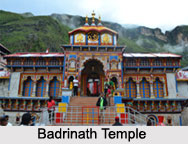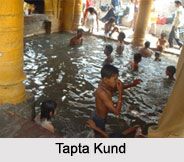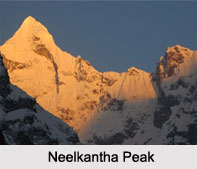 Tourism in Badrinathpuri includes the tourism destinations like Tapta Kund, Panch Shilas, Panch Dhara, Sesh Netra and Neelkanth peak.
Tourism in Badrinathpuri includes the tourism destinations like Tapta Kund, Panch Shilas, Panch Dhara, Sesh Netra and Neelkanth peak.
Badrinathpuri also known as Badrinath has vivid holy places of celestial importance that has bearings of the Hindu Gods and Goddesses. Badrinathpuri is the place of temples and Hindu monasteries. This place is associated with the religious fantasies and stories based on Indian mythology that looms in the folklore.
Badrinarayan Temple
 Badrinarayan Temple is an ancient Hindu temple. It is dedicated to Lord Vishnu. It is located in Badrinath in Uttarakhand. Badrinarayan Temple is one of the temples in the Char Dham and Chota Char Dham pilgrimage plan.
Badrinarayan Temple is an ancient Hindu temple. It is dedicated to Lord Vishnu. It is located in Badrinath in Uttarakhand. Badrinarayan Temple is one of the temples in the Char Dham and Chota Char Dham pilgrimage plan.
Tapta Kund
Tapta Kund is a natural hot water spring situated between the holy shrine of Badrinath and Alaknanda River. It is said that Tapta Kund is the dwelling place of Lord Agni. Before entering the Badrinath temple it has become a traditional practice to take a dip into the Tapta Kund.
Panch Shilas
 There are five Shilas or block of stones which are sheltered around the Tapta Kund. The five Shilas are namely Narad Shila, Narsingh Shila, Varaha Shila, Garur Shila and Markandey Shila.
There are five Shilas or block of stones which are sheltered around the Tapta Kund. The five Shilas are namely Narad Shila, Narsingh Shila, Varaha Shila, Garur Shila and Markandey Shila.
Panch Dhara
Panch Dhara is kown as the five river waterfalls- Prahlad, Kurma Avatar, Urvasi, Bhrigu and Indradharas. These five small waterfalls are originated from the Neelkanth, Nara and Narain peaks. Most astonishing fact is that all these five streams have the variation in temperatures. Prahlad Dhara has warm water whereas the Kurma Dhara has extremely cold water. Bhrigus is located at a distance of about one kilometer from Badrinathpuri, which is flowing beyond the large number of caves. The most beautiful water stream is Indra Dhara. It slides majestically down the Narayan Parbat. Indra Dhara is situated near Badrinathpuri (1.5 km).
Sesh Netra
Sesh Netra is located 1.5kms far from Badrinathpuri and there is a boulder having the impression of the Sesh Nag`s eye that is a natural creation and not credited to the human beings.
Neelkanth Peak
Neelkanth peak is crowned as the `Garhwal Queen`. It is because, this peak is soaring high above the Badrinath temple. Neelkanth peak is covered with snow and guarding the entire Badrinathpuri from the cold winds. Neelkanth peak symbolizes the purity of Badrinathpuri. Neelkanth peak not only attracted the people for the pilgrimage tourism, but also it attracted the people who love adventure. The history of this holy land is associated largely with Neelkanth peak.



















